Now Entering Another Dimension: Welcome to Arctic Field Science

Emmy Award-winning filmmaker Michael Werner and science and nature writer Meera Subramanian recently spent eight light-filled days and nights with MBL ecologists at Toolik Field Station in Arctic Alaska. Werner, whose soaring video impression of the remote ecological field site is above, says the experience was like entering another time dimension (read more from Werner here). Subramanian saw the fruits of a 35-years-running soil experiment come to bear, which she brings to life in the photo essay below, “The Pluck.” The journalists were 2015 recipients of an Arctic Field Experience fellowship from the MBL’s Logan Science Journalism Program.
The Pluck
By Meera Subramanian
About 35 years ago, when most ecologists were still musing about the coming ice age then predicted by climate models, young scientists John Hobbie and Gus Shaver of the MBL and Terry Chapin (now at University of Alaska, Fairbanks) set up camp on an old, abandoned airstrip at Toolik Lake on the North Slope of Alaska.
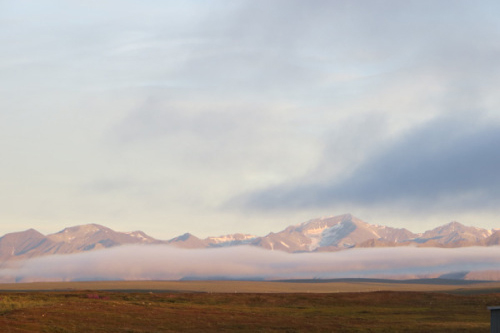
Scientists tinker, so when they gazed at this wild and beautiful yet nutrient-poor place, bereft of the nitrogen and phosphorous found in soils in temperate regions of the globe, they wondered what might happen to the Arctic terrain if they added such amendments. These men set into motion long-term experiments on tundra plots—not big ones, just 5 x 20 meters—that are still playing out today, providing more and more bits of information that begin to tell a story about what is happening in the Arctic regions—and why.

Their research site is now Toolik Field Station, the summer home to more than 100 Arctic ecologists from around the nation. The active growing season at Toolik is fleeting—the snowpack melts by mid-May yet flurries start falling again in late August. In those short months, the scientists work quickly to collect samples and monitor activity in the briefly thawed, top layer of permafrost. This season is especially hectic for Shaver, as he is overseeing “The Pluck”—the 35th-year harvest of one of their long-term soil fertilization experiments. Shaver calls The Pluck “an intense and exhausting week-long exercise that is the basis of many of our most cited publications from Toolik over the past 40 years.”
The last Pluck was in 2000, and this one is bigger and even more involved, with dozens of people collecting tundra samples and assailing them with a battery of tests. The overarching plan is to figure out what grows, crawls, respires, leaches, and more in the fertilized plots compared to the control plots—from the macro level of plant and animal species to the tiny stuff only discovered in chemical analyzers and under the lens of a microscope. It begins with Shaver simply heading up the hill from Toolik camp, getting down on the ground, and plunging a long, too-dull knife into the ground.
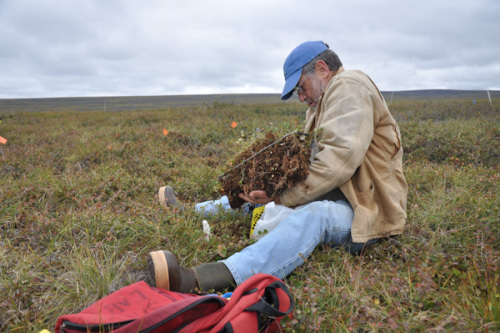
He takes this small hunk of the tundra, and 59 others like it, back down into the lab, where he’s rallied graduate and undergraduate students, visiting middle-school teachers and high-school students, and colleagues and family members to sort.
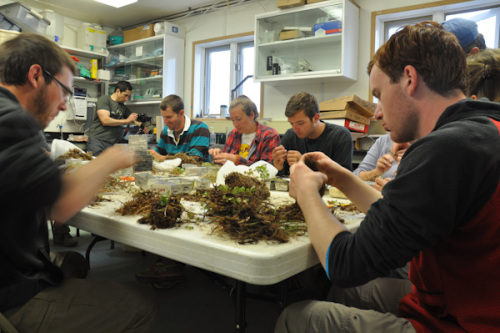
Lichens and feather mosses, woody birches and sedges with edges, cloudberry and more. Together, with background music from Spotify’s “Have A Great Day” playlist, they sort…
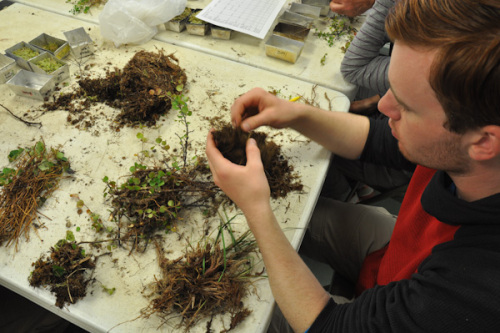
…and sort. This is the nitty-gritty stuff of science.
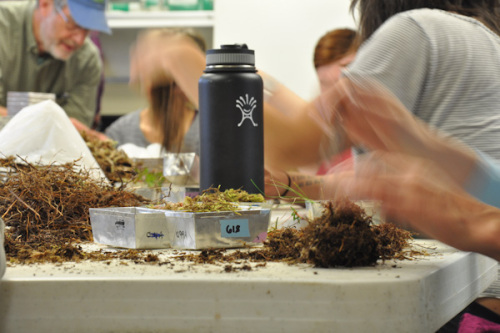
That’s just one part of The Pluck— one part in the trailer of Lab Two. In another corner of Lab 2, Jennie McLaren of the University of Texas, El Paso, leads nimble fingers and weary eyes as they separate roots from soil—a fuzzy distinction in these tundra plots. Over in the Lab 1 trailer, Josh Schimel (University of California, Santa Barbara) and his team pour potassium sulfate over soil and prepare samples to test for ammonium, phosphates, and nitrates. Across the way, in Lab 9, John Moore (Colorado State University) and crew —Greg Selby, Bob Faris and Yamina Pressler—work late into the night, enticing any of the insects lurking in the tundra chunks into bottles of ethanol. They divvy up the soil to hand off to other scientists in other labs preparing for other testing.
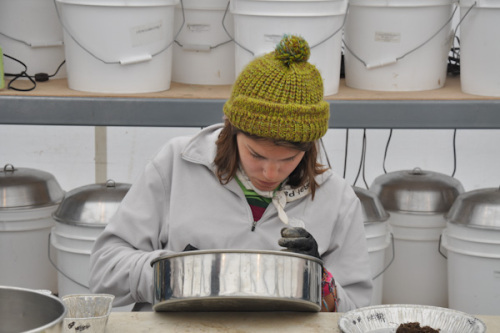
Other soil critters are sucked up and caught using a leaf blower set on a reverse. “Hello! Housekeeping!” Ashley Asmus (University of Texas, Arlington) calls out as she and Taryn Flink (also of UTA) approach others at work in the tundra plots.
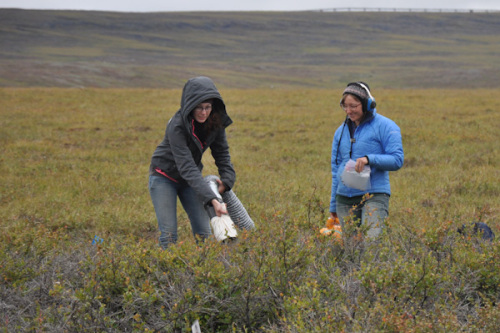
The whole Pluck takes about ten days, and then a year or more to process the data and make sense of what they’ve found. Researchers come from Massachusetts, Colorado, Michigan, California, and elsewhere to help with the Pluck, and many will take samples back to their labs at home to continue the work after these summer days at Toolik come to an end. The plant people and the root people, the soil people and water people will all need to talk, to bring the macro investigations into a greater focus. Will the results of earlier studies be confirmed? Is fertilized tundra replicating what a warming tundra might look like, with more microbial activity in thawing permafrost, supporting larger and woodier plants? Is more carbon being released with the underground microbial action? Is the Arctic ecosystem—once steady-state ice and frozen ground—fast becoming a huge, breathing part of the planet, exhaling more carbon than what humans are putting into the atmosphere? Or will all those bigger plants that are growing in the Arctic help suck carbon in, leading the ecosystem to a new equilibrium, a “new normal” for carbon exchange?
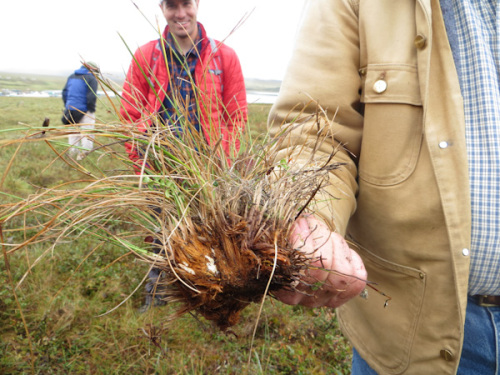
The planet might be warming, the plants and microbes shifting in response, but summer remains short at Toolik, less than three months from snow melt to snow fall. Just in the short time I’ve been here, the seasons have tipped. As scientists and students sort at Toolik Field Station, truckers haul their loads along nearby Dalton Highway, drawling to each other over CB channel 19:
“Sure came early, didn’t it?”
“Yeah. A few days of rain. A few nice days. A few days of rain. A few nice days. Then it’s fall.”

#####
For more information on long-term experiments at Toolik by MBL scientists, please visit the Arctic Long-Term Ecological Research site page. MBL Distinguished Scientist John Hobbie was founding director of the Arctic LTER in 1987; its current director is MBL Senior Scientist Gus Shaver. The Arctic LTER is part of a network of National Science Foundation long-term research sites.